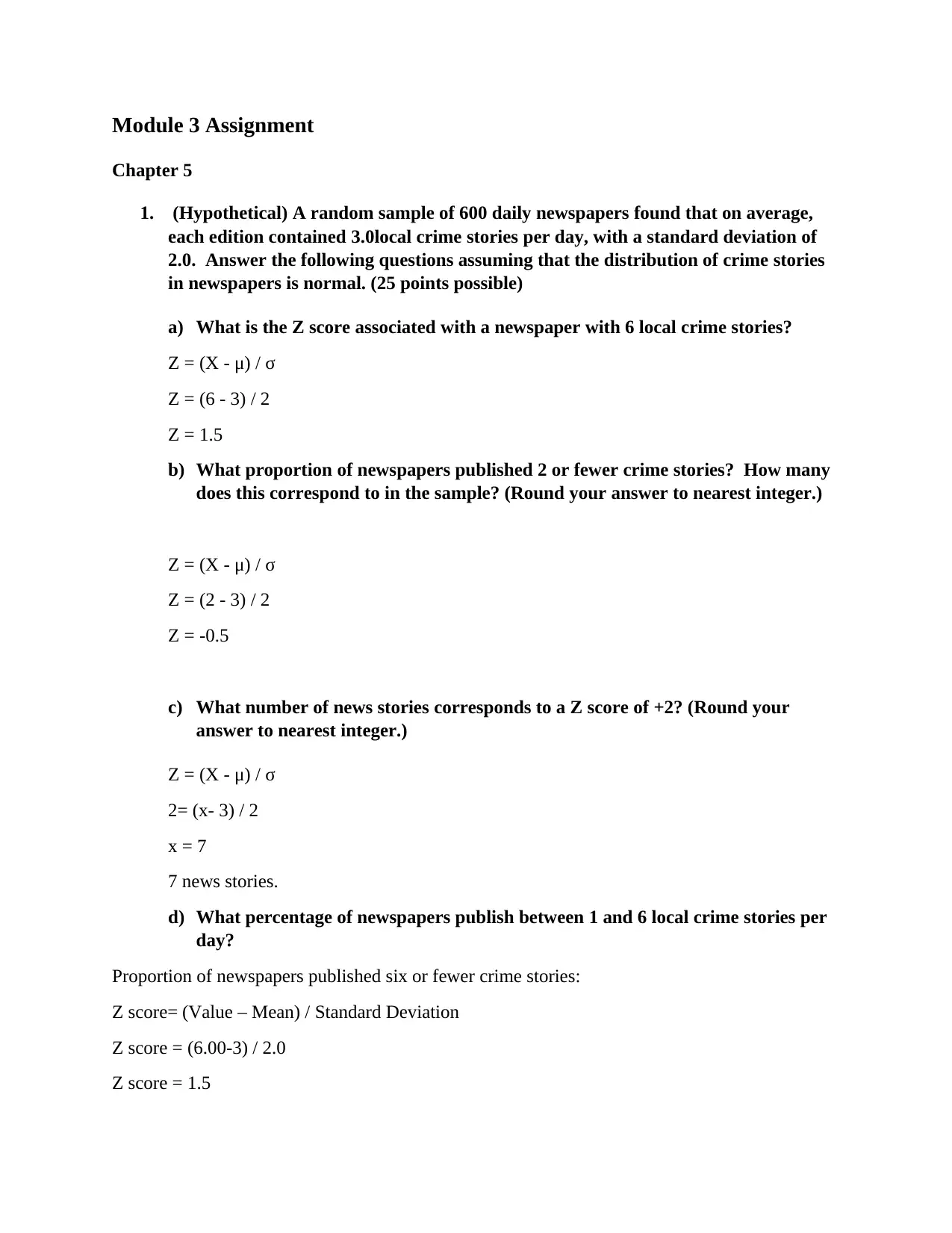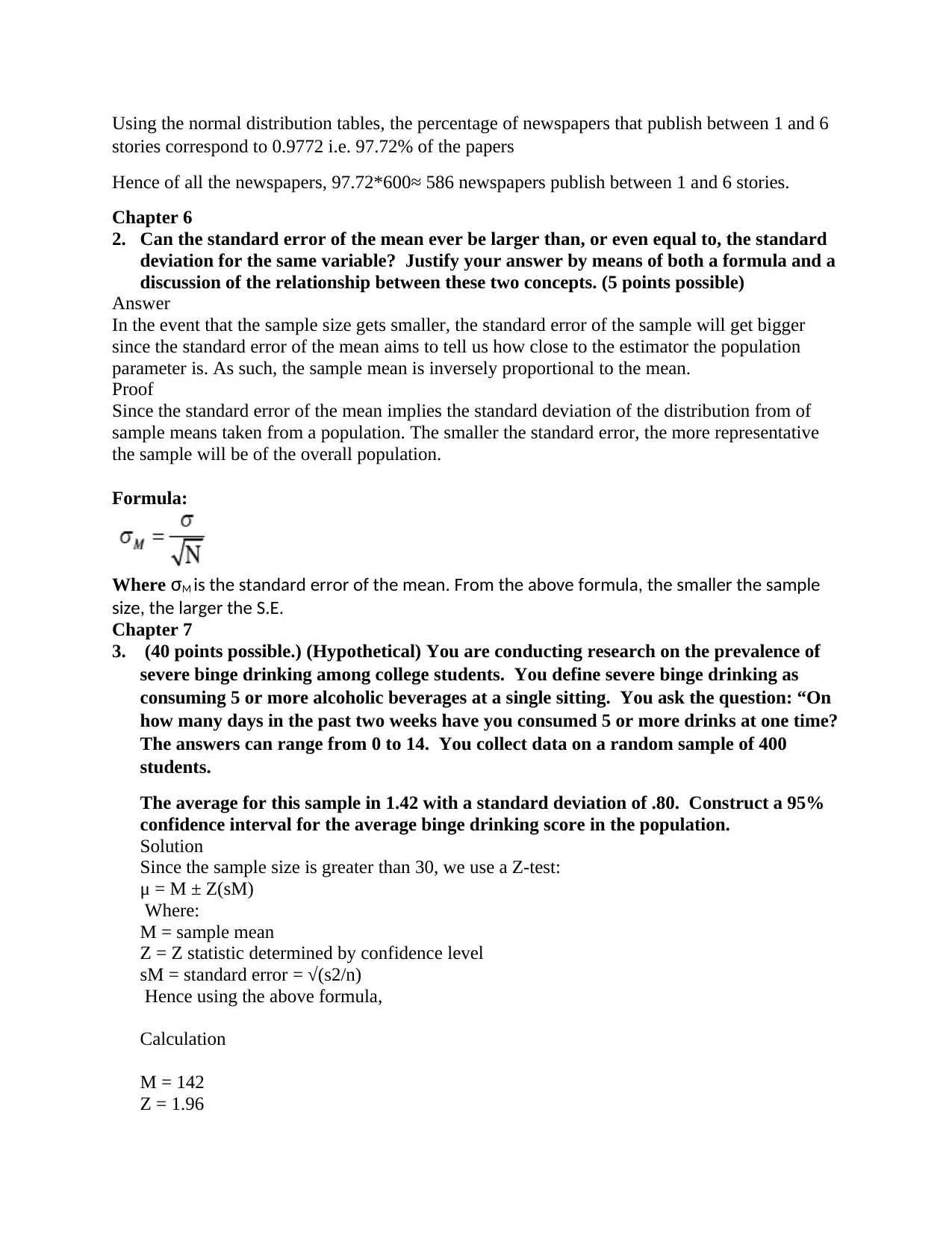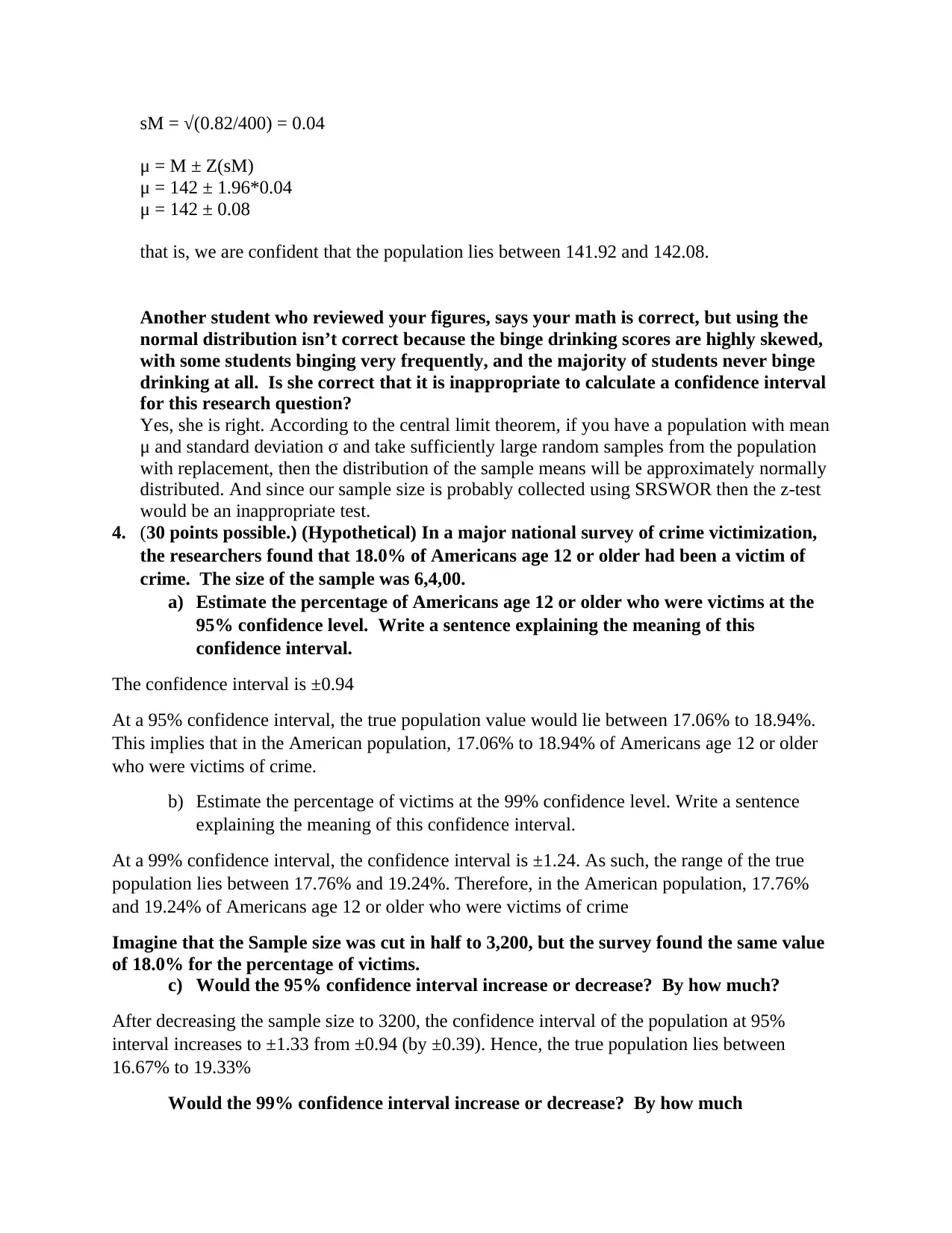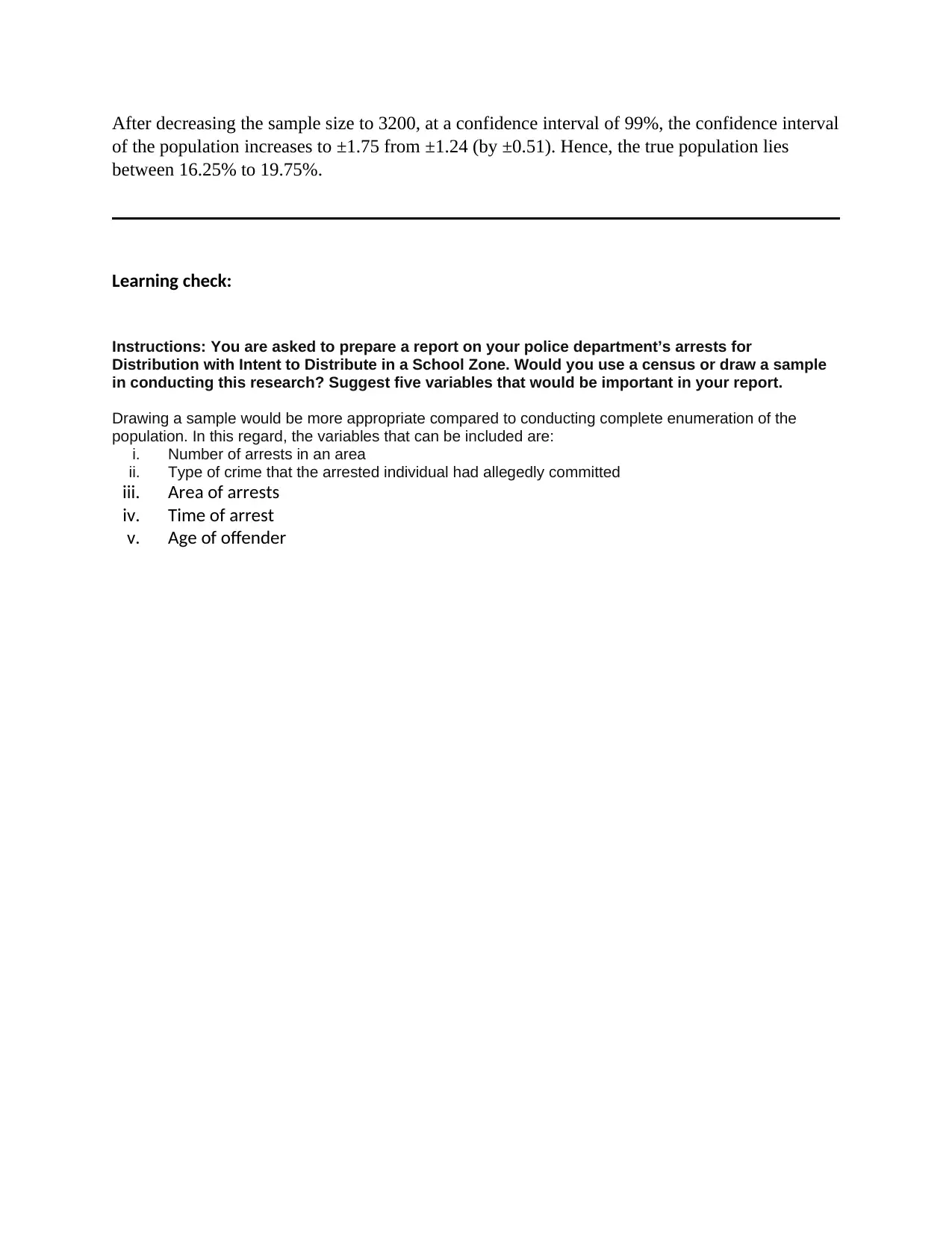University Statistics Assignment: Module 3 (Chapters 5-7) Analysis
VerifiedAdded on 2022/10/12
|4
|1262
|249
Homework Assignment
AI Summary
This assignment addresses statistical concepts through the analysis of hypothetical scenarios. It includes calculations of z-scores, proportions, and confidence intervals related to newspaper crime stories, binge drinking among college students, and crime victimization surveys. The assignment explores the standard error of the mean, its relationship to standard deviation, and the impact of sample size on confidence intervals. It also includes a learning check requiring the student to suggest variables for a police department report. The solutions demonstrate the application of statistical methods and the interpretation of results within the context of the given scenarios. The assignment covers topics from chapters 5, 6, and 7 of a statistics module.

Module 3 Assignment
Chapter 5
1. (Hypothetical) A random sample of 600 daily newspapers found that on average,
each edition contained 3.0local crime stories per day, with a standard deviation of
2.0. Answer the following questions assuming that the distribution of crime stories
in newspapers is normal. (25 points possible)
a) What is the Z score associated with a newspaper with 6 local crime stories?
Z = (X - μ) / σ
Z = (6 - 3) / 2
Z = 1.5
b) What proportion of newspapers published 2 or fewer crime stories? How many
does this correspond to in the sample? (Round your answer to nearest integer.)
Z = (X - μ) / σ
Z = (2 - 3) / 2
Z = -0.5
c) What number of news stories corresponds to a Z score of +2? (Round your
answer to nearest integer.)
Z = (X - μ) / σ
2= (x- 3) / 2
x = 7
7 news stories.
d) What percentage of newspapers publish between 1 and 6 local crime stories per
day?
Proportion of newspapers published six or fewer crime stories:
Z score= (Value – Mean) / Standard Deviation
Z score = (6.00-3) / 2.0
Z score = 1.5
Chapter 5
1. (Hypothetical) A random sample of 600 daily newspapers found that on average,
each edition contained 3.0local crime stories per day, with a standard deviation of
2.0. Answer the following questions assuming that the distribution of crime stories
in newspapers is normal. (25 points possible)
a) What is the Z score associated with a newspaper with 6 local crime stories?
Z = (X - μ) / σ
Z = (6 - 3) / 2
Z = 1.5
b) What proportion of newspapers published 2 or fewer crime stories? How many
does this correspond to in the sample? (Round your answer to nearest integer.)
Z = (X - μ) / σ
Z = (2 - 3) / 2
Z = -0.5
c) What number of news stories corresponds to a Z score of +2? (Round your
answer to nearest integer.)
Z = (X - μ) / σ
2= (x- 3) / 2
x = 7
7 news stories.
d) What percentage of newspapers publish between 1 and 6 local crime stories per
day?
Proportion of newspapers published six or fewer crime stories:
Z score= (Value – Mean) / Standard Deviation
Z score = (6.00-3) / 2.0
Z score = 1.5
Paraphrase This Document
Need a fresh take? Get an instant paraphrase of this document with our AI Paraphraser

Using the normal distribution tables, the percentage of newspapers that publish between 1 and 6
stories correspond to 0.9772 i.e. 97.72% of the papers
Hence of all the newspapers, 97.72*600≈ 586 newspapers publish between 1 and 6 stories.
Chapter 6
2. Can the standard error of the mean ever be larger than, or even equal to, the standard
deviation for the same variable? Justify your answer by means of both a formula and a
discussion of the relationship between these two concepts. (5 points possible)
Answer
In the event that the sample size gets smaller, the standard error of the sample will get bigger
since the standard error of the mean aims to tell us how close to the estimator the population
parameter is. As such, the sample mean is inversely proportional to the mean.
Proof
Since the standard error of the mean implies the standard deviation of the distribution from of
sample means taken from a population. The smaller the standard error, the more representative
the sample will be of the overall population.
Formula:
Where σM is the standard error of the mean. From the above formula, the smaller the sample
size, the larger the S.E.
Chapter 7
3. (40 points possible.) (Hypothetical) You are conducting research on the prevalence of
severe binge drinking among college students. You define severe binge drinking as
consuming 5 or more alcoholic beverages at a single sitting. You ask the question: “On
how many days in the past two weeks have you consumed 5 or more drinks at one time?
The answers can range from 0 to 14. You collect data on a random sample of 400
students.
The average for this sample in 1.42 with a standard deviation of .80. Construct a 95%
confidence interval for the average binge drinking score in the population.
Solution
Since the sample size is greater than 30, we use a Z-test:
μ = M ± Z(sM)
Where:
M = sample mean
Z = Z statistic determined by confidence level
sM = standard error = √(s2/n)
Hence using the above formula,
Calculation
M = 142
Z = 1.96
stories correspond to 0.9772 i.e. 97.72% of the papers
Hence of all the newspapers, 97.72*600≈ 586 newspapers publish between 1 and 6 stories.
Chapter 6
2. Can the standard error of the mean ever be larger than, or even equal to, the standard
deviation for the same variable? Justify your answer by means of both a formula and a
discussion of the relationship between these two concepts. (5 points possible)
Answer
In the event that the sample size gets smaller, the standard error of the sample will get bigger
since the standard error of the mean aims to tell us how close to the estimator the population
parameter is. As such, the sample mean is inversely proportional to the mean.
Proof
Since the standard error of the mean implies the standard deviation of the distribution from of
sample means taken from a population. The smaller the standard error, the more representative
the sample will be of the overall population.
Formula:
Where σM is the standard error of the mean. From the above formula, the smaller the sample
size, the larger the S.E.
Chapter 7
3. (40 points possible.) (Hypothetical) You are conducting research on the prevalence of
severe binge drinking among college students. You define severe binge drinking as
consuming 5 or more alcoholic beverages at a single sitting. You ask the question: “On
how many days in the past two weeks have you consumed 5 or more drinks at one time?
The answers can range from 0 to 14. You collect data on a random sample of 400
students.
The average for this sample in 1.42 with a standard deviation of .80. Construct a 95%
confidence interval for the average binge drinking score in the population.
Solution
Since the sample size is greater than 30, we use a Z-test:
μ = M ± Z(sM)
Where:
M = sample mean
Z = Z statistic determined by confidence level
sM = standard error = √(s2/n)
Hence using the above formula,
Calculation
M = 142
Z = 1.96

sM = √(0.82/400) = 0.04
μ = M ± Z(sM)
μ = 142 ± 1.96*0.04
μ = 142 ± 0.08
that is, we are confident that the population lies between 141.92 and 142.08.
Another student who reviewed your figures, says your math is correct, but using the
normal distribution isn’t correct because the binge drinking scores are highly skewed,
with some students binging very frequently, and the majority of students never binge
drinking at all. Is she correct that it is inappropriate to calculate a confidence interval
for this research question?
Yes, she is right. According to the central limit theorem, if you have a population with mean
μ and standard deviation σ and take sufficiently large random samples from the population
with replacement, then the distribution of the sample means will be approximately normally
distributed. And since our sample size is probably collected using SRSWOR then the z-test
would be an inappropriate test.
4. (30 points possible.) (Hypothetical) In a major national survey of crime victimization,
the researchers found that 18.0% of Americans age 12 or older had been a victim of
crime. The size of the sample was 6,4,00.
a) Estimate the percentage of Americans age 12 or older who were victims at the
95% confidence level. Write a sentence explaining the meaning of this
confidence interval.
The confidence interval is ±0.94
At a 95% confidence interval, the true population value would lie between 17.06% to 18.94%.
This implies that in the American population, 17.06% to 18.94% of Americans age 12 or older
who were victims of crime.
b) Estimate the percentage of victims at the 99% confidence level. Write a sentence
explaining the meaning of this confidence interval.
At a 99% confidence interval, the confidence interval is ±1.24. As such, the range of the true
population lies between 17.76% and 19.24%. Therefore, in the American population, 17.76%
and 19.24% of Americans age 12 or older who were victims of crime
Imagine that the Sample size was cut in half to 3,200, but the survey found the same value
of 18.0% for the percentage of victims.
c) Would the 95% confidence interval increase or decrease? By how much?
After decreasing the sample size to 3200, the confidence interval of the population at 95%
interval increases to ±1.33 from ±0.94 (by ±0.39). Hence, the true population lies between
16.67% to 19.33%
Would the 99% confidence interval increase or decrease? By how much
μ = M ± Z(sM)
μ = 142 ± 1.96*0.04
μ = 142 ± 0.08
that is, we are confident that the population lies between 141.92 and 142.08.
Another student who reviewed your figures, says your math is correct, but using the
normal distribution isn’t correct because the binge drinking scores are highly skewed,
with some students binging very frequently, and the majority of students never binge
drinking at all. Is she correct that it is inappropriate to calculate a confidence interval
for this research question?
Yes, she is right. According to the central limit theorem, if you have a population with mean
μ and standard deviation σ and take sufficiently large random samples from the population
with replacement, then the distribution of the sample means will be approximately normally
distributed. And since our sample size is probably collected using SRSWOR then the z-test
would be an inappropriate test.
4. (30 points possible.) (Hypothetical) In a major national survey of crime victimization,
the researchers found that 18.0% of Americans age 12 or older had been a victim of
crime. The size of the sample was 6,4,00.
a) Estimate the percentage of Americans age 12 or older who were victims at the
95% confidence level. Write a sentence explaining the meaning of this
confidence interval.
The confidence interval is ±0.94
At a 95% confidence interval, the true population value would lie between 17.06% to 18.94%.
This implies that in the American population, 17.06% to 18.94% of Americans age 12 or older
who were victims of crime.
b) Estimate the percentage of victims at the 99% confidence level. Write a sentence
explaining the meaning of this confidence interval.
At a 99% confidence interval, the confidence interval is ±1.24. As such, the range of the true
population lies between 17.76% and 19.24%. Therefore, in the American population, 17.76%
and 19.24% of Americans age 12 or older who were victims of crime
Imagine that the Sample size was cut in half to 3,200, but the survey found the same value
of 18.0% for the percentage of victims.
c) Would the 95% confidence interval increase or decrease? By how much?
After decreasing the sample size to 3200, the confidence interval of the population at 95%
interval increases to ±1.33 from ±0.94 (by ±0.39). Hence, the true population lies between
16.67% to 19.33%
Would the 99% confidence interval increase or decrease? By how much
⊘ This is a preview!⊘
Do you want full access?
Subscribe today to unlock all pages.

Trusted by 1+ million students worldwide

After decreasing the sample size to 3200, at a confidence interval of 99%, the confidence interval
of the population increases to ±1.75 from ±1.24 (by ±0.51). Hence, the true population lies
between 16.25% to 19.75%.
Learning check:
Instructions: You are asked to prepare a report on your police department’s arrests for
Distribution with Intent to Distribute in a School Zone. Would you use a census or draw a sample
in conducting this research? Suggest five variables that would be important in your report.
Drawing a sample would be more appropriate compared to conducting complete enumeration of the
population. In this regard, the variables that can be included are:
i. Number of arrests in an area
ii. Type of crime that the arrested individual had allegedly committed
iii. Area of arrests
iv. Time of arrest
v. Age of offender
of the population increases to ±1.75 from ±1.24 (by ±0.51). Hence, the true population lies
between 16.25% to 19.75%.
Learning check:
Instructions: You are asked to prepare a report on your police department’s arrests for
Distribution with Intent to Distribute in a School Zone. Would you use a census or draw a sample
in conducting this research? Suggest five variables that would be important in your report.
Drawing a sample would be more appropriate compared to conducting complete enumeration of the
population. In this regard, the variables that can be included are:
i. Number of arrests in an area
ii. Type of crime that the arrested individual had allegedly committed
iii. Area of arrests
iv. Time of arrest
v. Age of offender
1 out of 4
Related Documents
Your All-in-One AI-Powered Toolkit for Academic Success.
+13062052269
info@desklib.com
Available 24*7 on WhatsApp / Email
![[object Object]](/_next/static/media/star-bottom.7253800d.svg)
Unlock your academic potential
Copyright © 2020–2025 A2Z Services. All Rights Reserved. Developed and managed by ZUCOL.





